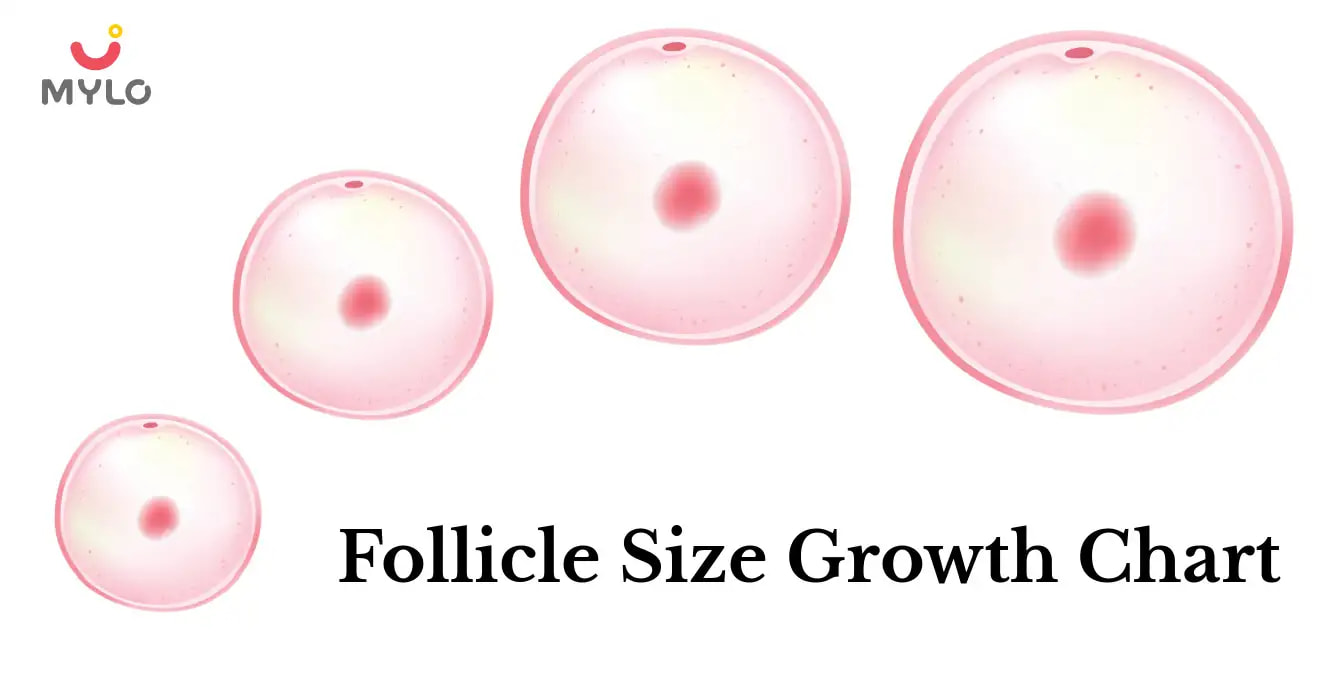Home

Reproductive health

The Ultimate Guide to Understanding a Follicle Size Growth Chart
In this Article

Reproductive health
The Ultimate Guide to Understanding a Follicle Size Growth Chart
Updated on 27 September 2023
The journey to conception is a complex process, and one of the key players in this process is the follicle. It can provide crucial insights into your reproductive health and help you navigate the complexities of conception. In this comprehensive guide, we'll break down the science behind follicle size growth charts, explain how they are used in fertility treatments, and highlight key milestones to look out for.
What is a follicle and its role in fertility?
A follicle is a small, fluid-filled sac that contains an immature egg. These follicles are found within a woman's ovaries. Each month, a few follicles begin to develop, but only one will mature and release an egg during ovulation. This mature follicle and the size of mature follicle is crucial for successful conception.
The follicle plays a vital role in fertility as it is responsible for nurturing the egg and providing it with the necessary environment to grow and develop. It produces estrogen, a hormone that prepares the uterus for pregnancy.
You may also like : Improve Egg Quality in 30 Days: The Ultimate Guide to Boosting Your Fertility Naturally
What are the factors that affect follicle size?
When it comes to follicle development, several factors come into play. The size of the follicle is influenced by various elements that can impact fertility, such as:
1. Age
As women age, the quality and quantity of their eggs decrease. This decline in egg quality can result in smaller follicles, making conception more challenging.
2. Hormonal imbalance
Hormonal imbalances, such as polycystic ovary syndrome (PCOS) or thyroid disorders, can disrupt the normal growth of follicles. These imbalances can lead to irregular or absent ovulation, affecting the size of the follicles.
3. Ovarian reserve
The ovarian reserve refers to the number of eggs a woman has in her ovaries. A lower ovarian reserve can result in smaller follicles, reducing the chances of successful conception.
4. Stress
Stress can impact fertility in various ways, including affecting the size of follicles. Chronic stress can disrupt the delicate hormonal balance necessary for proper follicle development.
5. Lifestyle factors
Lifestyle factors such as smoking, excessive alcohol consumption, and poor nutrition can negatively impact follicle size. Maintaining a healthy lifestyle and making positive choices can contribute to optimal follicle development.
You may also like : Understanding Follicular Study: A Comprehensive Guide to Female Fertility
Why is it important to track a follicle size growth chart?
Here are five reasons why it is important to track a follicle size:
1. Determining ovulation
Monitoring the growth of follicles can help determine the timing of ovulation. By tracking the size of follicles, couples can identify the optimal time for intercourse to maximize their chances of conception.
2. Assessing follicle health
A growth chart allows couples to assess the health of the follicles. If the follicles are consistently small or fail to grow, it may indicate underlying fertility issues that need to be addressed.
3. Identifying hormone imbalances
Tracking follicle size can help identify hormone imbalances that may be hindering conception. If the follicles are consistently large or fail to rupture, it may indicate hormonal irregularities that require medical intervention.
4. Monitoring fertility treatment progress
For couples undergoing fertility treatments such as in vitro fertilization (IVF) or intrauterine insemination (IUI), tracking follicle size is crucial. It helps monitor the response to medications and determines the optimal time for procedures.
By tracking a growth chart, couples can gain valuable insights into their fertility and take proactive steps to optimize their chances of conception.
You may also like : Female Fertility and Fertility Treatments: A Comprehensive Guide
Understanding different stages of follicle development
Follicle development occurs in multiple stages, each with its unique characteristics. Understanding these stages can help couples interpret the data provided by a follicle size growth chart accurately. Here are the different stages of follicle development:
1. Primordial Follicles
Primordial follicles are the earliest stage of follicle development. These follicles contain immature eggs that are not yet ready for ovulation. They are present in the ovaries from birth and remain dormant until activated.
2. Primary Follicles
Primary follicles are the next stage of follicle development. During this stage, the follicles start to grow and develop. They are surrounded by a single layer of cells that nourish the immature egg.
3. Secondary Follicles
Secondary follicles are characterized by an increased number of cells surrounding the egg. These cells produce estrogen, which prepares the uterus for pregnancy. At this stage, multiple secondary follicles may be present, but only one will continue to develop further.
4. Graafian Follicle
The Graafian follicle is the mature follicle that is ready for ovulation. It is the largest follicle and contains a fully developed egg. Once the Graafian follicle ruptures, the egg is released into the fallopian tube, ready to be fertilized.
You may also like : Hysteroscopy: Everything You Need to Know About This Minimally Invasive Procedure
What is the egg follicle size at ovulation?
The size of the egg follicle at ovulation is a crucial indicator of fertility. It determines the readiness of the egg for fertilization and successful conception. Typically, the egg follicle reaches its maximum size just before ovulation. The average size of mature follicle is around 18 to 25 millimeters.
Monitoring the size of the egg follicle is essential to identify the optimal time for intercourse or fertility treatment procedures. If the follicle is too small, it may indicate that ovulation has not yet occurred. On the other hand, if the follicle is too large, it may indicate that ovulation has already passed.
You may also like : Ovulation Induction: Understanding Meaning, Process and Natural Alternatives
What is the right follicle size for conceiving?
Optimal follicle size is vital for successful conception. The size of the follicle plays a crucial role in determining the quality of the egg and the chances of fertilization. While the ideal follicle size may vary, generally, a follicle size between 18 to 25 millimeters is considered optimal for conceiving.
A follicle of this size indicates that the egg has reached maturity and is ready to be released during ovulation. It increases the chances of successful fertilization and implantation, leading to a healthy pregnancy.
What is the required follicle size for pregnancy?
Once conception occurs, the role of the follicle does not end. The size of the follicle continues to be relevant during early pregnancy. After fertilization, the follicle transforms into the corpus luteum, which produces progesterone, a hormone crucial for supporting the early stages of pregnancy.
Maintaining an appropriate follicle size during pregnancy is essential for the production of adequate progesterone. A well-developed corpus luteum ensures a healthy pregnancy and provides the necessary hormonal support for the developing embryo.
Tips for optimizing follicle size
Here are five tips to optimize follicle size and improve your chances of successful conception:
1. Maintain a healthy lifestyle
Adopting a healthy lifestyle is crucial for optimal follicle development. Eat a balanced diet, exercise regularly, and get enough sleep. Avoid smoking, excessive alcohol consumption, and stress, as they can negatively impact follicle size.
2. Consult a fertility specialist
If you are struggling to conceive or have concerns about egg follicle size at ovulation, consult a fertility specialist. They can assess your unique situation, perform necessary tests, and provide guidance on optimizing follicle development.
3. Track your menstrual cycle
Understanding your menstrual cycle is essential for tracking follicle size accurately. Keep a record of your cycle length, ovulation symptoms, and any irregularities. This information can help identify patterns and time intercourse or fertility treatments more effectively.
4. Consider fertility medications
In some cases, fertility medications may be prescribed to stimulate follicle growth. These medications can help regulate the hormonal balance and promote the development of healthy follicles.
5. Stay positive and patient
Fertility journeys can be emotionally challenging, but it is important to stay positive and patient. Optimizing follicle size for conceiving takes time, and each person's journey is unique. Trust the process and seek support from your partner, loved ones, or support groups.
By implementing these tips, couples can optimize follicle size for pregnancy and increase their chances of successful conception.
Key Takeaways
Understanding the intricacies of a follicle size growth chart is crucial for couples on their fertility journey. By comprehending the role of a follicle in fertility, the factors that affect follicle size, and the importance of tracking follicle development, couples can navigate their conception process more effectively. Remember, every fertility journey is unique, and seeking guidance from a fertility specialist can provide personalized advice and support.
References
1. Murase T, Iwase A, Komatsu K, Bayasula, Nakamura T, Osuka S, Takikawa S, Kikkawa F. (2018). Follicle dynamics: visualization and analysis of follicle growth and maturation using murine ovarian tissue culture. J Assist Reprod Genet.
2. Newcombe JR, Cuervo-Arango J. (2013). Growth rate of ovulatory follicles during the first ovulatory oestrus (after seasonal anoestrus) and subsequent oestrous period in Irish Draught mares. Ir Vet J.
3. Abbara A, Vuong LN, Ho VNA, Clarke SA, Jeffers L, Comninos AN, Salim R, Ho TM. (2018). Follicle Size on Day of Trigger Most Likely to Yield a Mature Oocyte. Front Endocrinol (Lausanne).



Written by
Anandita Sharma
Drawing on more than a decade of expertise in administration, Anandita Sharma currently serves as a content operations e
Read MoreGet baby's diet chart, and growth tips

Related Articles
Related Questions
Hello frnds..still no pain...doctor said head fix nhi hua hai..bt vagina me pain hai aur back pain bhi... anyone having same issues??

Kon kon c chije aisi hai jo pregnancy mei gas acidity jalan karti hain... Koi btayega plz bcz mujhe aksar khane ke baad hi samagh aata hai ki is chij se gas acidity jalan ho gyi hai. Please share your knowledge

I am 13 week pregnancy. Anyone having Storione-xt tablet. It better to have morning or night ???

Hlo to be moms....i hv a query...in my 9.5 wk i feel body joint pain like in ankle, knee, wrist, shoulder, toes....pain intensity is high...i cnt sleep....what should i do pls help....cn i cosult my doc.

Influenza and boostrix injection kisiko laga hai kya 8 month pregnancy me and q lagta hai ye plz reply me

RECENTLY PUBLISHED ARTICLES
our most recent articles

PCOS & PCOD
Fruits for PCOS: Your Guide to Making Healthy Choices

PCOS & PCOD
Is Milk Good for PCOS: Exploring the Dairy Dilemma

PCOS & PCOD
The Ultimate Guide to Using Ashokarishta for PCOS

PCOS & PCOD
PCOS Pain: The Ultimate Guide to Causes and Effective Management

Leisure
10 Best Mystery Books to Read in 2023

Books
10 Best Non-Fiction Books to Read in 2023
- Is Ghee Good for PCOS: The Ultimate Guide to Benefits and Ways to Consume
- Is Curd Good for PCOS: The Ultimate Guide to Debunking Myths and Discovering Benefits
- Dark Chocolate for PCOS: Unlocking the Potential of a Guilt-Free Indulgence
- Beetroot for PCOS: Discovering a Natural Approach to Managing Symptoms
- Soy for PCOS: Should You Eat it or Avoid It?
- Cinnamon for PCOS: Discovering the Natural Support You've Been Missing
- When Do Babies Start Walking?
- The Ultimate Guide to 4th Month Pregnancy Symptoms
- Your Guide to 2 Months Pregnant Symptoms: What to Expect
- The Ultimate Balanced Diet Chart: Your Guide to Optimal Nutrition
- Mundan Ceremony: A New Parent's Guide to Customs, Traditions and Celebrations
- Dates for PCOS: How to Harness their Health Benefits
- Coconut Water for PCOS: Discovering the Natural Support You've Been Missing
- Everything You Need to Know About the Length of Vagina


AWARDS AND RECOGNITION

Mylo wins Forbes D2C Disruptor award

Mylo wins The Economic Times Promising Brands 2022
AS SEEN IN
















- Mylo Care: Effective and science-backed personal care and wellness solutions for a joyful you.
- Mylo Baby: Science-backed, gentle and effective personal care & hygiene range for your little one.
- Mylo Community: Trusted and empathetic community of 10mn+ parents and experts.
Product Categories
baby carrier | baby soap | baby wipes | stretch marks cream | baby cream | baby shampoo | baby massage oil | baby hair oil | stretch marks oil | baby body wash | baby powder | baby lotion | diaper rash cream | newborn diapers | teether | baby kajal | baby diapers | cloth diapers |








